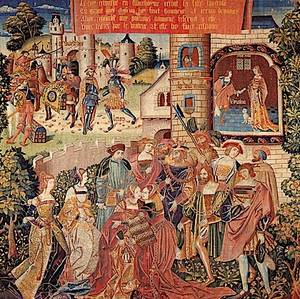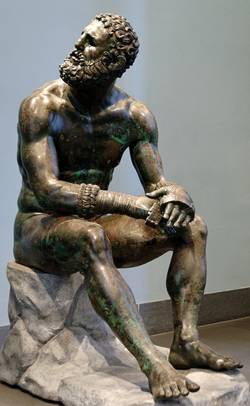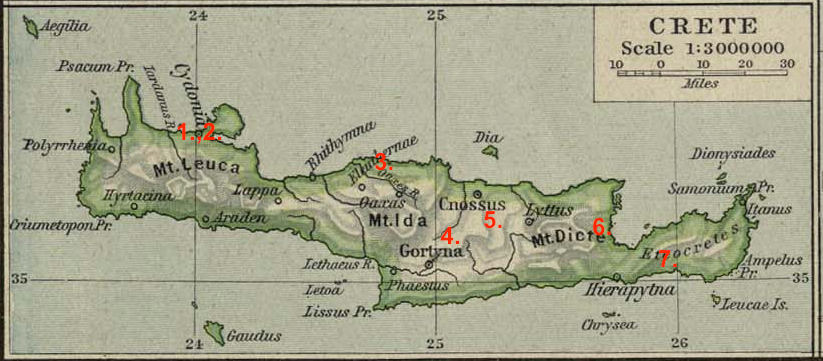At the Bargello museum in Florence a small and delightful exhibition in the two rooms off the medieval courtyard is running until 21st June. Il medioevo in viaggio is the result of collaboration between four European museums (the Bargello, the Musée du Moyen Âge in Paris, the Museu Episcopal of Vic in Catalonia, and the Museum Schnütgen of Cologne). The exhibition has already been shown in Paris and will move on in the summer to Vic. Here in Florence it also celebrates the Bargello’s 150th anniversary and it is the last exhibition to be held under the excellent curatorship of Beatrice Paolozzi Strozzi, who has now retired as Director.
It has much of interest for Blue Guide users, and for all those who love travel.

The exhibition begins with a fascinating portolano (or portulan) of c. 1440. This is a parchment map showing coastal harbours (with the rulers of the day shown sitting in their tents). Also on show is the oldest nautical chart known, dating from the 14th century, which illustrates the behaviour of the winds. These precious parchments are both preserved in Florence at the Biblioteca Nazionale Centrale and the Archivio di Stato.
The history of pilgrimage is illustrated with more intimate artefacts, including a codex from Lyon showing a bishop blessing two pilgrims’ bags and staffs before they set out on their journey. Early medieval leather shoes and badges and brooches worn on hats and cloaks are on display, and tiny portable altars in porphyry (used when Mass was celebrated on the road) include one probably made in Winchester in the 11th century. Even baptisms could be performed en route, and a little 13th-century wooden salt cellar, in the form of a church with a bell-tower, was evidently used to produce Holy Water for such a ceremony. One of the very few paintings in the exhibition (loaned from Vic) shows a 15th-century Flight into Egypt, clearly referring to contemporary travel, since the Holy Family are accompanied by a maidservant carrying their luggage on her head and a cow is being led along beside them so milk would be available for the Child, and there is another group of travellers in the background.
Crusaders and their horses are recorded with 13th-century bits and stirrups. A beautiful very well preserved 14th-century miniature from the Bargello illustrates a city being besieged by land and sea. An ivory plaquette is of twofold interest: its smooth back with traces of wax has proved it was used by a traveller to take notes, and its recto is carved with a scene of two crusaders holding their noses to block the stench emanating from the bodies of Christian soldiers killed in the Seventh Crusade to the Lebanon in 1253 after they had been exposed too long in the sun, but which the conscientious St Louis IX is happily burying. This saintly king of France reigned for 44 years and was a great reformer and founded the Sainte-Chapelle in Paris for his collection of relics: but he was no good as a crusader and died of dysentery on a voyage to Tunis.
Another extraordinarily precious possession of the Biblioteca Nazionale Centrale of Florence is a 1392 edition of the Il Milione of Marco Polo, one of the most famous travellers of all time. The ring with an engraved ruby, thought to have belonged to the Black Prince himself, made in England in the 14th century (lent by the Louvre), is appropriately displayed above a brooch made in France in the same century and now in the Bargello. They both have very similar enamel and gold decoration as well as identical inscriptions from St Luke, which indicate that they were considered talismans designed to bring luck to the wearer.
Caskets for valuables, trunks and bags and portable folding furniture are also part of the display. An octagonal table with Gothic carvings, dating from the late 15th century, was evidently taken on trips by its wealthy owner since it could be ‘closed up’ so it fitted snugly against a saddle. The exhibition closes with a wonderful tapestry made in France in the early 16th century illustrating a popular medieval legend but chosen for this show because it includes a charming detail of a mule being loaded with trunks as a group of travellers prepare to set out on a journey.
by Alta Macadam, author of Blue Guide Florence.









